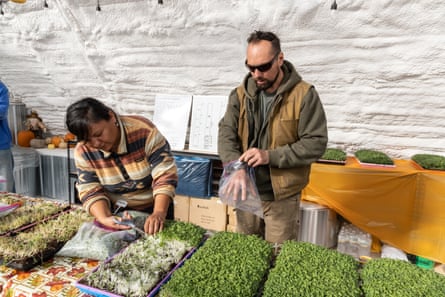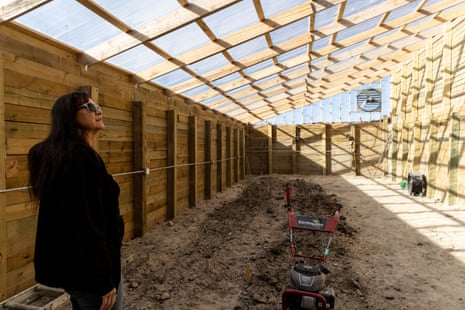Near the southern border of the Pine Ridge Reservation in South Dakota, a curved translucent roof peeks out a few feet above the dusty plains. It’s a blustery November afternoon and the last remaining greens outside are fading fast. But below ground, at the bottom of a short flight of stairs, the inside of this 80ft-long sleek structure is bursting with life – pallets of vivid microgreens, potato plants growing from hay bales and planters full of thick heads of Swiss chard and pak choi. Two people bend over the pallets, using scissors to harvest delicate sprouts of microgreens.
This is an underground greenhouse, or walipini, and the harvesters are members of the Oglala Sioux Tribe. It is one of at least eight underground greenhouses that, over the past decade, have been built or are being constructed on the reservation – which has one of the highest poverty rates in the US. Some hope they can help solve the interconnected problems of the lack of affordable, nutritious food and the difficulties of farming in the climate crisis.

Underground greenhouses, emerged three decades ago in Bolivia as a way of trying to help rural communities gain food security. Their conditions can be controlled to protect the crops from fierce storms and extreme temperatures.
Those underground on the reservation use geothermal energy to keep a stable year-round temperature of about 52F, and some use a series of tubes that capture and circulate heat from deeper underground. At the same time, the greenhouses absorb and bank heat from the sun.
Surrounded by the Badlands and Black Hills, the Pine Ridge Reservation has long faced extreme weather. But the climate crisis is ushering in more intense rainstorms and heatwaves and residents on the reservation say the situation is becoming untenable.
In July 2019, Julian Bear Runner, then president of the Oglala Sioux Tribe, testified to the US House natural resources committee about a recent storm that had flooded residents’ homes and made roads impassable. “Our Reservation is not in a position to handle another severe weather storm,” he told the committee.
Just one month later, an intense storm swept through the reservation producing golf-ball-sized hail and wind gusts of up to 80mph. It tore siding off of a local school, shattered windows and wiped out outdoor crops.
At the Pine Ridge school, the severe weather destroyed a growing tunnel built three years before by Daniel Nelson, a former school facility manager, and local students. “It just ripped those poles out of the ground, lifted the whole greenhouse up and it just twisted it,” he says.
Nelson is now building an underground greenhouse, funded by a grant of about $6,000 from a social impact fund. When finished, the 20ft by 40ft structure will sit 8ft below ground. He hopes that will make it much more resilient when the next big storm sweeps through.
Nelson expects to use the produce for his family as well as other local families. “We want to be able to feed ourselves. That’s our goal,” he says. “Because we don’t put a lot of stock in the system of grocery stores. One storm knocks that all out.”
Natalie Hand lives in a trailer on the reservation just feet from another underground greenhouse currently under construction. It is 8ft below ground, with a polycarbonate roof angled south to let in the sunlight and long timber beams set against packed dirt to trap in heat.
In the summer, a large thermostat-controlled exhaust fan on the west side and louvered vents on the east are expected to help pull out hot air. But during the winter, the plan is to rely on the sun to keep the plants warm. She thinks the new structure will provide much needed protection. “The storms are getting harsher and harsher here,” says Hand, who works for the non-profit Conscious Alliance. “This past summer, we had tremendous hail storms that took out a lot of gardens.”

Conscious Alliance distributes shelf-stable food to about 25 families a week on the reservation and sometimes to the 14 schools. The hope is that the underground greenhouse, which was funded through a $250,000 grant from a social impact fund, will allow them also to provide fresh produce.
Traditionally, the Lakota people were buffalo hunters and keen gatherers. But after the US government confined them to reservations in the late 19th century, and the US army helped decimate buffalo populations, growing their own food was one way to adapt.
Geneva Lone Hill says her grandparents and great-grandparents did that. “We had food all winter long. We didn’t worry about going to the store,” says the 70-year-old Wakpamni Lake Community president. “That’s what we want to get back to.”
Today, more than half of the residents of Oglala Lakota county, one of three counties within the boundaries of the reservation, live below the poverty line. Food access is a huge problem. The 2.1m-acre reservation is classified as a “food desert” with only a handful of grocery stores. And health outcomes, including diet related diseases, are poor – about 50% of adults over 40 have diabetes.
“This is a third world country in the middle of the United States,” says Bryan Deans, president of Oglala Lakota Cultural & Economic Revitalization Initiative, a community development project on the reservation. “You can either look at it as if it’s hopeless, you can’t do anything … Or you can look at it as well, nothing’s been done here, so anything can be done here,” he says.
About seven years ago, Deans constructed a 1,200 sq ft earthship-style underground greenhouse next to his home in the Slim Buttes Community on the west side of the reservation. Using dirt-filled tires for the walls and other salvaged materials, he and other community members were able to construct the greenhouse in three weeks for about $3,500, which they raised through crowdfunding.
The greenhouse uses a passive solar system in which the building acts as a thermal battery, absorbing heat and releasing it back into the building when the sun goes down. Most years the 4ft deep greenhouse grows at least 65,000 plant starters.
Deans says he’s able to use the plants from the greenhouse and his broader permaculture garden to feed as many as 400 people during a 10-day annual event in which he teaches visitors about the greenhouse and other projects on his property.
Underground greenhouses can be difficult to get right. There is the direction and angling of the roof to consider, as well as how deep to dig and which plants to grow. One misstep can dent chances of success.

Chance Weston, food sovereignty director of the Thunder Valley Community Development Corporation in Porcupine, a small town on the reservation, has spent the past several months reworking an underground greenhouse the non-profit organization built about six years ago. The structure, which he estimated cost about $30,000 to build, is part of its Food Sovereignty Initiative, which aims to create a more sustainable food system on the reservation, and was funded through grants and donors.
Recently, Weston’s team had to pull out all of the microgreens because of a fungal problem probably caused by colder temperatures at night and moisture getting into the structure. He says he’s working to add better ventilation and boosting the structural integrity to keep the winds and rain out to fix the situation.
Weston hopes to be able to use the greenhouse to grow traditional plants that his ancestors were known to gather, including Timpsila, chokecherries and buffalo berries. Much of the space may be devoted to growing starter plants year-round. “If we have a garden that’s wiped out, it’s good if we have starters that are already so far along,” he says.
Russel Finch, owner of the Greenhouse in the Snow, an underground greenhouse business in Alliance, Nebraska, says he has sold nearly 600 structures in the US, Canada and Europe. But, he cautioned, they are not replacements for large commercial greenhouses. Finch says that for his model, those larger than 102ft long risk having ventilation and heating problems, because the blowers circulating air from underground may have trouble reaching the entire space.
The cost to build the greenhouse is typically around the same price as an above-ground greenhouse, he says – his are sold for $211 a foot – but they are much cheaper to operate because they use the ambient earth temperature to keep the climate constant, and are protected from the wind.
Neil Mattson, professor and greenhouse extension specialist at Cornell University’s School of Integrative Plant Science, says underground greenhouses could help to usher in more year-round food production across the northern US but they are still fairly new in the country. “There’s not a lot of scientific research or peer-reviewed research,” he says. “But I see them as kind of a resurgence of interest in homesteading and food resilience,” Mattson says.
They could also have an environmental advantage, says Theresa Ong, assistant professor of environmental studies at Dartmouth College. “I think that if we converted all the greenhouses in these cold climates to some kind of version of this, we would definitely improve our greenhouse gas emissions to some extent … And maybe reduce reliance on fossil fuels in our food system,” she says.
The Wakpamni Lake Community, on the west side of the Pine Ridge Reservation, built their underground greenhouse in response to the pandemic, which further reduced the already limited grocery options.

Within days of Covid reaching the region, leadership voted to use about $15,000 raised through sponsorships, grants and partnerships, which had been earmarked for a laundromat, to build the greenhouse. Raycen Raines says at about 80ft in length, the greenhouse is about the same size as the community’s outside garden, but is able to produce 12 times as much produce by operating all year round.
The day-to-day work is done by a team of about 20 community members, hired as day laborers and known as the “green team”. The community distributes baskets of harvested produce to some of the more than 300 community members that have opted in to the free program or give it out during Sunday bingo.
They are also building a second underground structure and plan on constructing more of various sizes across the community, Raines says.

Calsee Has No Horse, 30, a single mother of three children, ages nine, seven and 18 months says she started receiving baskets from the underground greenhouse last year.
Although initially unsure of what to do with the produce, these days she throws the microgreens into many of her children’s meals – from sandwiches to cheese dips.
“I always worried about: how am I going to get them their healthy foods, their nutrients, their veggies? Because I’m struggling as it is,” Has No Horse says. “Once we started getting these it was a big relief.”










